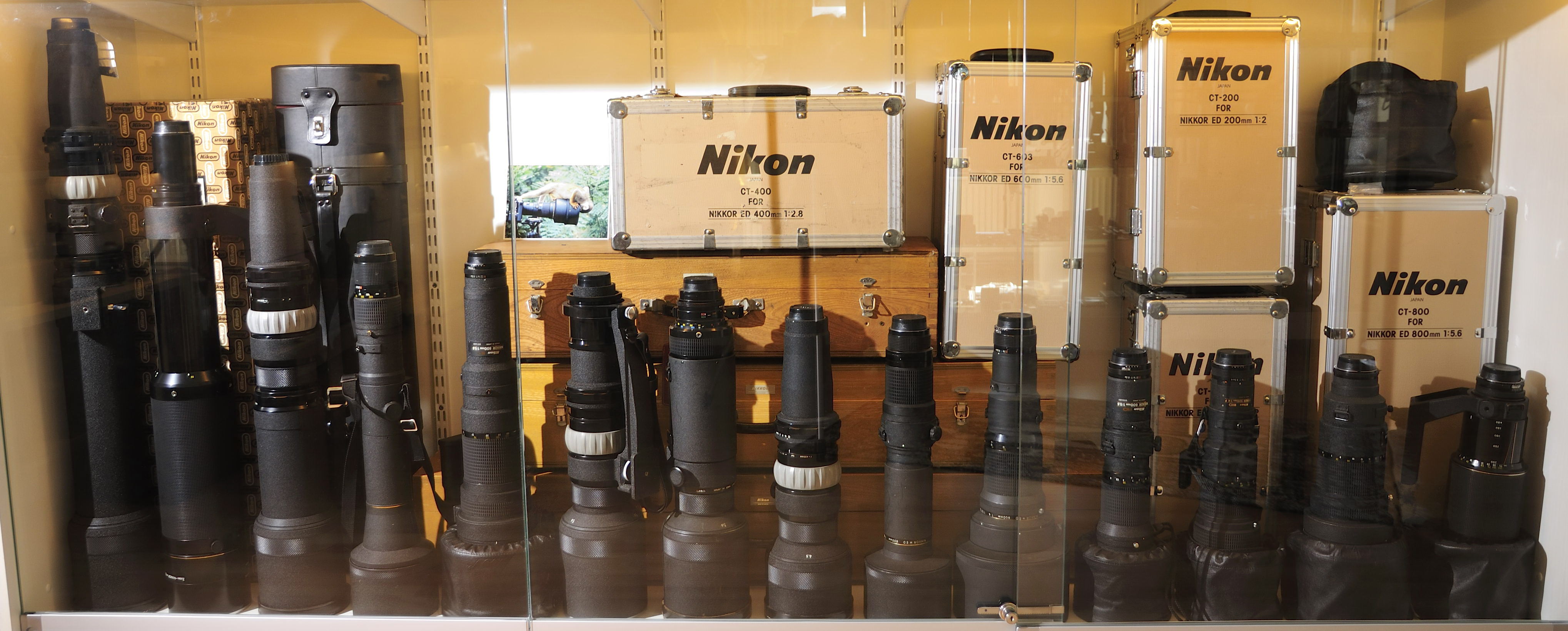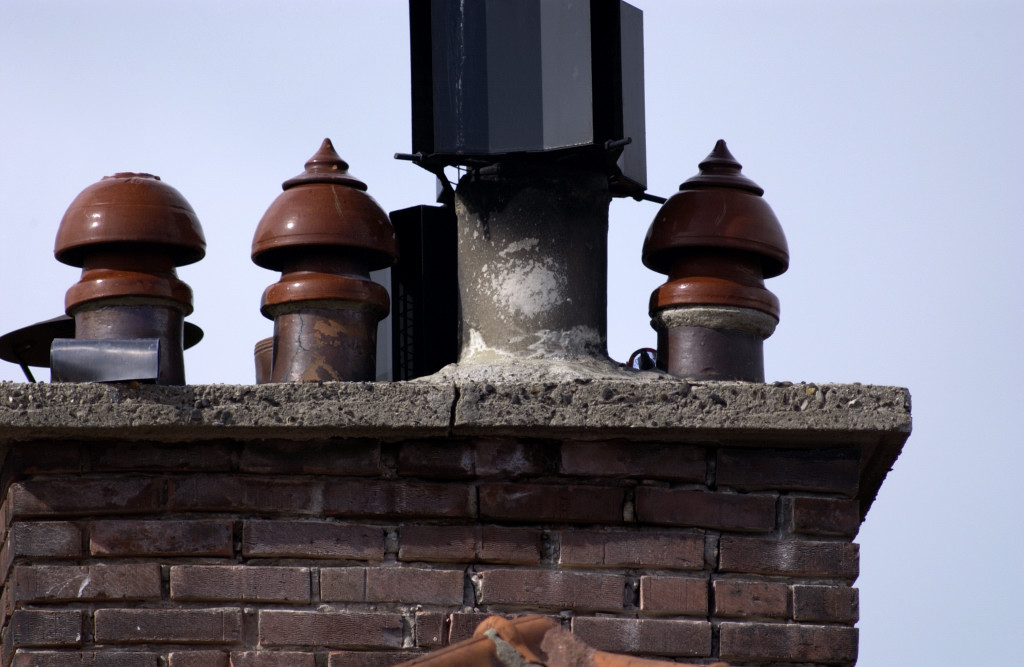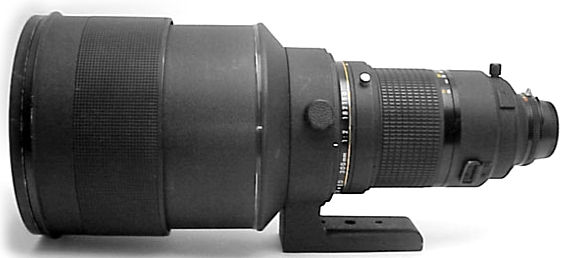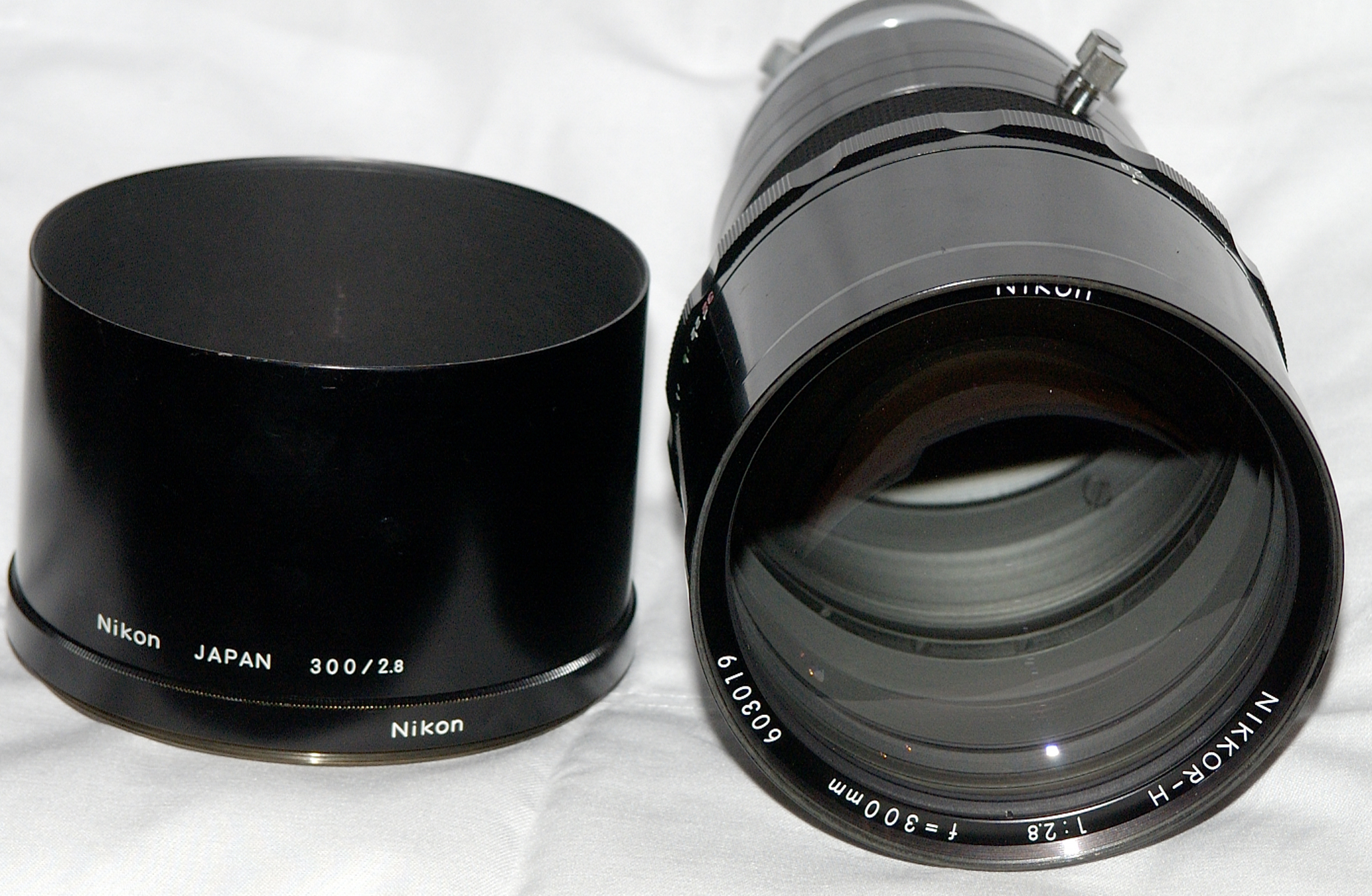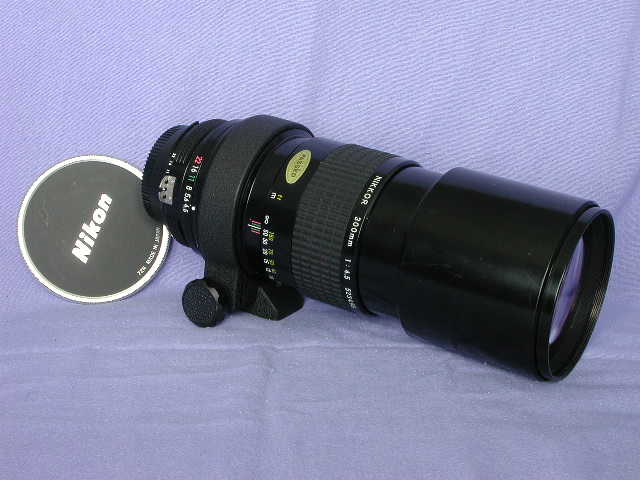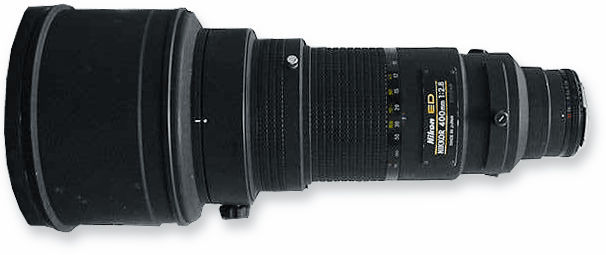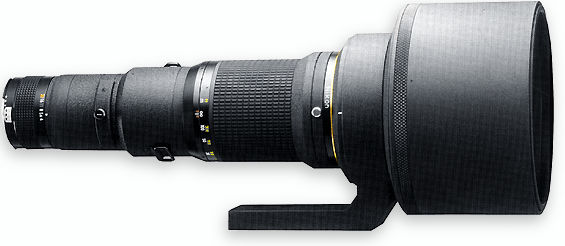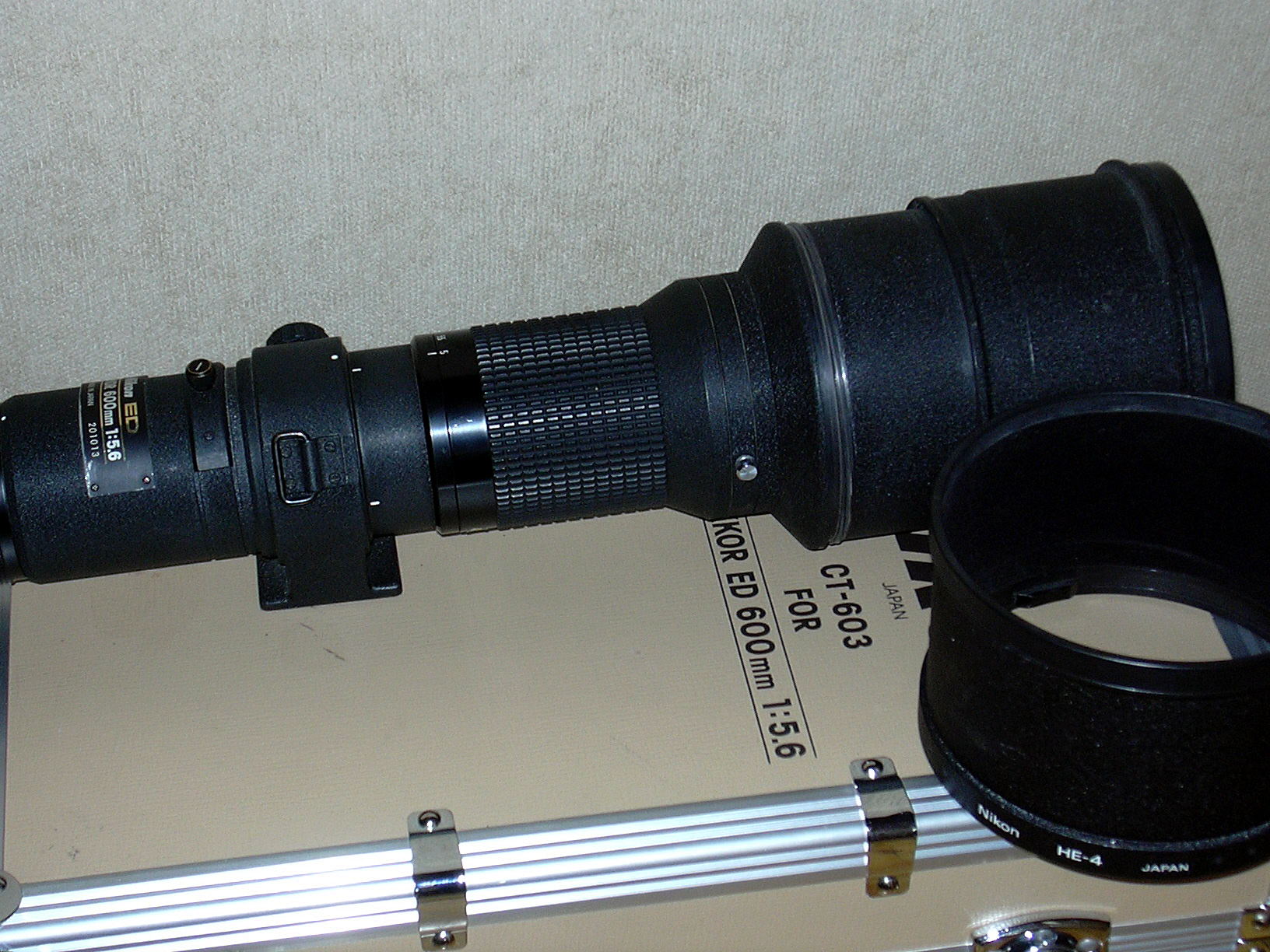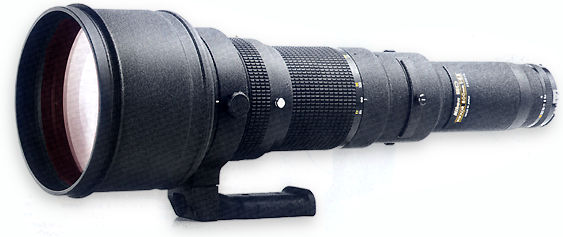Nikon long tele-lenses
Nikon Corporation surprised many photographers with lenses many photographers never thought it would be possible to produce. With lenses with fixed focal lengths from 300 up to 1200 mm. (see above) in various maximum apertures every photographer can master any situation. Some lenses are produced in low quantities and became very rare. Nikon must have known this, but wanted to show the world its abilities. For an overview see this matrix No comment is needed in reviewing these lenses. All of them are masterpieces of optical engineering and can be used full open without any reservations. One stop from wide open an image may become a bit sharper and DOF increases, but these lenses are made for shooting at full aperture. As their weights vary from 1.100 gram (4.5/300mm.ED) up to a hefty 7,000 gram (2/300 mm.) at least one monopod or tripod is necessary. Using longer lenses on a digital DX-format reflex camera may multiply focal length but the risk of blurred images because of vibration, too. Aerial vibrations may also be annoying when shooting long distance objects. Note 1: most of the lenses reviewed below have a large front element, some made of ED-glass. To avoid using a large 122 mm filter on the front most fast lenses have a slip-in filter (39 mm or 52 mm) near the aperture ring. One should never remove that filter as it is part of the optical formula. Note 2: for the AF-versions of the lenses see the relevant chapter (AF-lenses and VR-lenses) Reviews are nice to write, but to produce visual proofs of the quality of a lens is more convincing. Below you´ll see a shot of a chimney at a distance of approx. 50 meters. The picture was taken with the ´stovepipe´ Nikkor-AIS 5.6/600 mm. mounted on a Nikon D1X (ISO-125), both on one Gitzo tripod. The camera was set on the ´anti-mirror shock mode´ and the self timer of 10 sec. was used. The lens was set at full open aperture.
The same picture was taken with a similar lens made by another Japanese lens maker. From two sections of the entire image enlargements have been made, so you can see a ´close-up´ of both pictures. Judge by yourself. at the right is the close-up of the image made with the Nikkor. again, at the right side the Nikkor result.
2/300 mm.
Maybe the most impressive 300mm. lens, and certainly the heaviest - is the super fast Nikkor 2/300 mm. IF-ED! This 7 kilo barrel filled with 11 elements (some in ED glass) in 8 groups is sharp from edge to edge at full open aperture. It was produced from 1981 till 1990 in a relatively low quantity (less than 500 lenses), because of its huge price (three times the price of a 2.8/300 mm.!). An AI/S-version was introduced early 1984, fitted with a UV-front filter and longer hood. Filter size is 122 mm. or a slip-in filter of 52 mm. An extra hood (HE-1) was available. 2.8/300 mm. One stop less faster was the Nikkor-H 2.8/300mm., of which several prototypes were presented in the 1970´s. One of those rare prototypes you'll see below. The lens engravings suggest that the lens has the famous ED-glass. Early 1972 the first lens with #603011 was introduced featuring ED-glass made by Schott AG in Germany (founded in 1884 by the German chemist Otto Schott). Only 72 lenses with Schott glass were made; pictured is lens No. 9 !! Late 1975 Nikon introduced the same lens with home made ED-glass; first #604011. Rare Nikkor-H 2.8/300 mm. (prototype) mounted on a very rare motorized Nikon F High Speed with special High Speed Viewfinder
Nikkor-H 2.8/300 mm ED (glass made by Schott AG). In 1977 the first version - Nikkor-AI 2.8/300 mm IF-ED - was introduced, followed in 1982 by the AIS (see below) and in 1985 by a new redesigned IF-ED-version (with name plate on the barrel) . Nikkor 2.8/300 mm. IF-ED AI/S A few years later the AF-version was put on the market. All MF-versions have 8 element in 6 groups, can be used with a 122 mm. screw-in filter or a 39 mm slip-in filter. They are weighing in at 2,500 gram.
4.5/300 mm. The oldest in the 300 mm lens stable is the manual Nikkor-P 4.5/300 mm. (6 elements in 5 groups), which was introduced in 1964. In 1977 it adapted the AI- and in 1981 the AIS-system. An almost identical version (but 6 elements in 4 groups) was presented in 1975, featuring an ED-element. This Nikkor-ED adapted the AI-system in 1977 as well. About one year later this Nikkor-ED ( 7 elements in 6 groups) was fitted with the IF (internal focusing) feature, followed by an AIS-version in 1982. This version is the best of the whole range. It is razor sharp and - weighing in at 1 kilo - handholdable.
Nikkor-AI/S 4.5/300 mm.
2.8/400 mm.
At its introduction in 1985 it was the world's fastest 400 mm. lens! This 5+ kilo giant has an optical formula of 8 elements in 6 groups. It has to be used with a 52mm slip-in filter. Minimum distance is 4 meter. Although it has a built-in hood the use of an extra HE-3 hood is advisable. There is only one version of this lens, as in 1994 it was succeeded by an AF-I-version.
3.5/400 mm. The first version of this lens was at its introduction in 1976 also the world's fastest 400mm.! Its optical formula consists of 8 elements in 6 groups. The first two elements from the front are made of ED-glass, so be careful or mount a 122 mm filter. There is also a slip-in filter of 39 mm, which should stay in for ever. An AI/S-version was introduced in 1982. This lens is just half a stop less faster than his faster brother but with 2800 gram it is nearly half in weight. An underrated lens; full open giving excellent images. Also wen used with the Nikon TC-301 teleconverter.
4.5/400 mm. Nikkor-Q 4.5/400 mm. The first 400mm. lens was the Nikkor-Q 4.5/400 mm. It was in fact the (last) member of the Nikon ´Super Telephotos´ lens system, in which on one focusing unit - CU-1 (later AU-1) - four (initially three) separate front-element units can be screwed in, enabling the camera body to remain attached to the CU-1 while changing the focal length. The first front-elements were the 5.6/600mm, 8/800 mm and the 11/1200 mm. - introduced in 1964 - followed by the 4.5/400 mm. in 1966. This series of optical masterpieces were produced until 1978. They all can be used at wide open aperture, giving razor sharp images. They are a bit heavy (1.9 - 3.5 kilo) and long (46 - 93 cm.), but excellent optics, even at nowadays standards.
5.6/400 mm. In 1973 the Nikkor 5.6/400 mm. was introduced, in 1975 succeeded by an ED-version. This rather underrated lens is an excellent performer, especially the IF-ED version in AI-mount which was presented in 1978. The optical formula of all models consists of 5 elements in 3 groups. The production of the last version ended in 1983. 4/500 mm. This lens was born - in 1988 - as a Nikkor 4/500 mm IF-ED P. That ´P´ indicates that the lens has a CPU incorporated, which integrates in the matrix metering system of the contemporary cameras like the Nikon F4, F-801 (alias N-8008) and F-90 (alias N-90). The lens has 8 elements (of which 3 are made of ED-glass) in 6 groups, can be focused (via Internal Focusing) down to 5 meter and should be used with a 39mm slip-in filter. A protective front-UV-filter is standard. This beautiful performer weighs in at nearly 3 kilo. It was succeeded by various AF-versions from 1993.
4/600 mm.
This more than 5 kilo heavy professional telelens was introduced in 1977. It has an optical formula of 8 elements in 6 groups, internal focusing and came with the Nikon TC-14 teleconverter. In 1982 the lens was altered a bit and in 1985 it became the AI/S coupling ring. Needless to say that this ia an excellent performer.
5.6/600 mm. In this focal length Nikon offers ´only´ two versions, but what a marvelous lenses they are! The first one - the ´stovepipe´ pictured below - is a bit difficult to work with, because of its weight (2.7 kilo) and length of close to one meter! Look at the pictures on top of this page, they say more than words! The first version, introduced in 1964, is the 3.6 kilo heavy Nikkor-P to be used on the Nikon FU and/or AU-1 focusing unit. It has 5 elements in 4 groups and can be focused down to a (disappointing) 11 meters! In 1974 an updated lens was introduced featuring the new coating. Finally in 1978 followed by a version with ED-glass elements. Two years earlier a modern design of the lens was introduced, featuring 7 elements (of which two are made of ED-glass) in 6 groups, internal focusing and a minimum focusing distance of 5.5 meter. In 1977 the AI-version was introduced, followed by the AI-S-version in 1982 and - finally - in 1985 an updated version with a protective UV-front filter.
one of Nikon´s beautiful ´stovepipes´: Nikkor-AIS 5.6/600 mm ED + extra HE-4 hood + CT-603 trunk
5.6/800 mm.
In 1986 this 5.5 kilo super telelens with internal focusing, 8 elements in 6 groups was introduced. At the front an UV-filter is mounted for protection. At that time it was the world's fastest 800mm.! Only some 3,000 lenses were made. The 5.6/800 mm. is one of the sharpest but least known telephoto lenses. Of the 8 elements the second, third and eighth element are made of ED-glass. Because of the fast f/stop 5.6 in most auto focus cameras the auto focus indicator in the viewfinder is able to assist the photographer. Most AF-systems in Nikon SLR cameras work with manual or auto focus lenses with a maximum aperture of f/5.6 only.
8/800 mm. Here Nikon shows what is possible in the optical world. Many manufacturers were producing lenses with focal lengths up to 2000 mm., but none of them gained respect with its optical quality. Nikon has shown its engineering performance by launching lenses like the one pictured below. Maybe not usable for all-day photography but if you need to ´catch´ an animal or object far away this is the tool with an enormous resolving power, resulting in a razor sharp image. Lenses with focal lengths of 800 mm and more are expensive, heavy and rare. The first version, 8/800 mm. as part of the CU-1 (later AU-1) system, introduced in 1964, comes close to 5 kilo and 1 meter in length. The second version - introduced in 1973 - has the modern coating on all elements. In 1975 Nikon made an ED-version. In 1976 a new design was introduced see picture below). It was not necessary to use the FU or AU-1 focusing unit. The optical formula was changed as well: 9 elements (of which 3 are made of ED-glass) in 7 groups, internal focusing, 39mm-slip-in filter and a minimum distance of 10 meter. An AI- and AI-S-version were introduced in 1978 and 1982 respectively. All lenses can only be used with a very strong support, like two tripods or a large bag with rice on the roof of a car.
11/1200 mm.
The first version of the 1200 mm with the focusing unit. the last version with its trunk. This amazing lens is much underrated, maybe because of its size and ´slow´ aperture. The very first version (Nikkor-P) belongs to the group to be mounted on the AU-1 focusing unit. This 6 kilo heavy stovepipe has a minimum focusing distance of 43 meter!! In 1973 it received a special coating. The second version (see above) was introduced in 1978 as Nikkor 11/1200 mm IF-ED. It has five individual elements of which the first two are of ED-glass. All elements are grouped in front, the rest is a long tube. The minimum focusing distance is 14 meters, but in wildlife photography a Nikon PK-11A macro ring can decrease this minimum distance without losing light or sharpness. A very rare lens, so if you find one, buy it.
|
